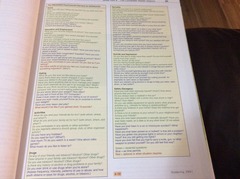1. State the purpose of the complete health history.
To collect subjective data and combine it with objective data from the physical examination and diagnostic tests.
Ill person's history includes a detailed, chronological record of the health person.
All history's include abnormal symptoms, health problems and concerns.
Parts of a health history
1. Biographical data - name, DOB etc,
2. source of history - patient, family, interpreter,
3. Reason for seeking care - 1 or 2 symptoms and duration,
4. Present health/history of present illness with symptom analysis,
5. Past health events - injuries, hospitalizations etc.
6. Family history,
7. Review of body systems,
8. Functional assessment - ADL's etc.
Sign
Objective abnormality that can be detected by examination or lab values.
Symptom
Subjective sensation that the patient feels; cannot be observed. Use quotations to include the patients words.

HEEADSSS
Adolescent interview focus:
Home environment,
Education and employment,
Eating,
peer-related Activities,
Drugs,
Sexuality,
Suicide/depression.
Safety from injury/violence.
developmental history points
Children:
1. Prenatal/perinatal history
2. Issue description and who provided the details,
3. Childhood illness, accidents and shots,
4. Developmental overview,
5. Nutritional history,
Consider developmental age in functional assessment.
Elderly:
Consider in ADL's due to having or chronic health changes.
Impact or burden of the disease.
Medication reconciliation
Comparison between and old and current list of media
2. List and define the critical characteristics used to explore each symptoms the patient identifies.
symptom analysis includes:
1. Location- precise location of issue,
2. Character/quality- sharp, dull, burning, aching, etc.,
3. Quantity/severity- use pain scale, dressing changes, etc,
4. Timing- onset, duration, frequency
5. Setting- issue associated location or activities,
6. Aggravating or relieving factors- what makes it worse, brings it on, or makes it better.
7. Associated factors- other related symptoms/causes,
8. Patient's perception- impacts/meaning to patients life.
P Q R S T U
symptom analysis order pneumonic:
P: Provocative/palliative - What brings it on? Activity happening when you first noticed it? What makes it better? Worse?
Q: Quality/quantity - How severe is it? Look, feel, sound?
R: Region/radiation - Where is it? Does it spread out?
S: Severity scale - Rating on scale? Is it improving/worsening?
T: Timing = When did it start? How long? How often?
U: Understand patients perception- What do you think it means?
3. Define the elements of the health history: reason for seeking care; present health state or present illness; past history, family history; review of systems; functional patterns of living.
1. Reason for seeking care- brief, spontaneous statement in patients own words.
2. Present health state- statement about the general state of health.
3. Past history- important since they may have residual effects on the current health state.
4. Review of systems- evaluate past & present health state of each body system.
5. Functional patterns of living- measures a persons self care ability.
4. Discuss the rationale for obtaining a family history.
Highlights those diseases/conditions that a particular patient may be at increased risk for.
5. Define a pedigree or genogram.
Graphic family tree in at least 3 generations such as parents, grandparents, and siblings.
6. Discuss the rationale for obtaining a systems review.
1. evaluate the past and present health state of each body system.
2. double check incase any significant data were omitted in the present illness section.
3. evaluate health promotion practices.
7. Describe the items included in a functional assessment.
spiritual resources, activity/exercise, sleep/rest, nutrition/ elimination, coping/ stress management, self esteem, self concept, interpersonal relationships, personal habits, occupational health, environmental hazard, and alcohol or illicit street drugs.
